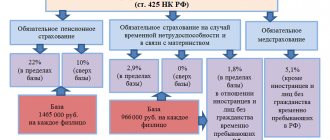Salary in accounting: basic operations
Payroll accounting is carried out within the framework of the following main operations:
- payroll;
- personal income tax withholding and salary contributions;
- making other deductions (for example, alimony under writs of execution);
- salary payments (advance, main part);
- payment of taxes and wage contributions to the budget.
These business operations may be supplemented by others, which are determined by the peculiarities of the production process at the enterprise. For example, by depositing salaries.
Each of the noted transactions must be reflected in the accounting registers. They are carried out at different times, which can be determined based on the specifics of tax accounting at the enterprise and the requirements of labor legislation.
Let's study how the timing of the noted transactions for accounting is established, as well as what entries are used when calculating and paying wages.
Labor compensation accrued: postings
Salaries must be paid at least every half month. For example, until the end of the current month for the first half and until the middle of the next month for the second half. Thus, the generally accepted approach is that the components of salary are:
- An advance paid before the end of the billing month.
Accounting records only reflect the fact of payment of the advance (later in the article we will look at the entries used for such purposes).
- The main part of the salary paid at the end of the payroll month.
If wages are accrued, the posting is as follows: Dt 20 Kt 70 - for the amount of wages for the entire month (regardless of the amount of the advance payment transferred).
In this case, the posting can also be generated by debit of accounts:
- 23 - if the salary is intended for employees of auxiliary production;
- 25 - if salaries are transferred to employees of industrial workshops;
- 26 - if the salary is accrued to management;
- 29 - when calculating wages to employees of service industries;
- 44 - if salaries are paid to employees of trade departments;
- 91 - if the employee is engaged in an activity that is not related to the main one;
- 96 - if the salary is calculated from reserves for future costs;
- 99 - if payments are calculated from net profit.
The salary accrual date is determined based on tax accounting standards, according to which salaries are recognized as income only at the end of the billing month (clause 2 of Article 223 of the Tax Code of the Russian Federation).
Pre-setting
Before you start calculating insurance premiums, you need to do a little setup of the program. The correctness of the calculations depends on it. Insurance premiums are a serious matter, so do not neglect the settings and be careful.
If you have not previously indicated the taxation system of your organization, be sure to do so in your accounting policy.
Accounting setup
First of all, let's start setting up accounting for our contributions. They are set up in the same place as the salary. In the “Salary and Personnel” menu, select “Salary Settings”.
Our team provides consulting, configuration and implementation services for 1C. You can contact us by phone +7 499 350 29 00 . Services and prices can be seen at the link. We will be happy to help you!
By clicking on the “Insurance Premiums” hyperlink in the “Classifiers” section, you can view the parameters for calculating premiums. We will not focus on them, since the data in these registers is already filled in in the standard configuration delivery according to current legislation.
Now let's move on to setting up accounting for our contributions. In the salary settings form, select “Salary accounting procedure”.
At the very bottom of the form that opens, follow the link to set up insurance premiums.
In the window that opens, go to the “Insurance Premiums” section and fill in the required fields.
The tariff for NS and PP is set depending on the main type of activity for the previous year. The minimum tariff is 0.2 percent. It is approved by the FSS, to which documents are submitted every year to confirm the main type of activity.
Here you can also set up additional contributions for those professions who are entitled to them, and indicate whether there are employees with hazardous working conditions. At the very bottom you can put a mark on the transfer of additional insurance contributions for a funded pension in accordance with Federal Law No. 56 of April 30, 2008.
Expenditures
To correctly reflect insurance premiums in accounting, you need to make one more setting. In the salary setup form, select “Cost items for insurance premiums.” This is where the procedure for reflecting mandatory contributions from the payroll fund on accounting accounts is set up.
A list already filled in by default will open in front of you. If necessary, it can be supplemented or adjusted.
By default, the debit account will be 26, the credit account will be 69.
Accruals
There are many different types of accruals. This includes salary, sick leave, vacation and others. For each of them, you need to configure whether insurance premiums should be paid from them.
Let's return to the salary settings form. In the “Payroll calculation” section, select the “Accruals” item.
A list of all charges will appear in front of you. They can be edited or new ones added.
Open any accrual. You will see the “Type of Income” field. It is the value indicated in it that will determine whether insurance premiums will be calculated on it or not. In our example, we opened one of the standard accruals, so everything is already filled in here, but when adding new ones, do not forget to indicate the type of income.
Calculation of salary taxes and contributions: accounting features
Immediately after payroll is calculated:
1. Personal income tax
The fact of calculation and withholding of personal income tax is reflected in the accounting registers by posting Dt 70 Kt 68.
If a personal income tax deduction is applied to wages, then it does not need to be reflected in accounting.
2. Insurance premiums.
The fact of their accrual is reflected by posting Dt 20 Kt 69.
As in the case of salary postings, correspondence can also be generated by debits of such accounts as 23, 25, 26, 29, 44 and others that we discussed above.
The accrual of personal income tax and contributions is shown, like the accrual of wages, on the last day of the month.
Personal income tax and contributions are calculated on the total amount of salary without any adjustment for the advance payment.
From November 30, 2020, the cashier is not required to require a passport from the recipient of funds to identify him.
When the salary is issued, the postings will be as follows.
Checking settlements with the budget for fixed insurance contributions to the Pension Fund
To check the calculations with the budget for insurance premiums in a fixed amount credited to the Pension Fund, you can create the report Account Analysis 69.06.5 “Mandatory Pension Insurance for Entrepreneurs”, section Reports - Standard Reports - Account Analysis.
We see that the debt on insurance premiums of individual entrepreneurs has been repaid.
See also:
- Payment of fixed contributions by an individual entrepreneur on income over 300 rubles.
Did the article help?
Get another secret bonus and full access to the BukhExpert8 help system for 14 days free of charge
Related publications
- Payment of contributions to the Pension Fund for income over 300 thousand rubles. individual entrepreneur Insurance premiums for an entrepreneur are divided into two parts. One is fixed...
- An individual entrepreneur with employees on the simplified tax system of 6% can sometimes reduce the tax by the full amount of fixed contributions. Entrepreneurs working on a “profitable” simplified tax system and having employees on staff…
- About the STD-PFR form (Information on labor activity provided from the PFR information resources) The STD-PFR form contains the same information as the form...
- Why does an incorrect calculation base arise from fixed accruals in the presence of absences? ...
Salary issued (reflected on the employee’s personal account): postings
The fact of salary payment is reflected in accounting by posting Dt 70 Kt 51 (or 50).
A similar posting is used when paying an advance.
The date of formation of the above posting for salary or advance payment is determined based on the date of each payment.
In this case, the actual amount of the “basic” labor payment is calculated minus the advance and personal income tax. It turns out that the tax is “withdrawn” from the corresponding amount, although it is charged on the total salary (the summed amount of the “basic” payment and advance payment). This circumstance reflects the specifics of tax accounting.
In accounting, therefore, in any case, the following should be distinguished:
- advance amount;
- the amount of the “basic” payment.
Postings of payment of wages in terms of the advance and its second half are recorded in the accounting registers on the day the funds are issued to employees.
After all the transfers, the employees’ personal payroll accounts are filled out (on Form T-54). Information is entered into them monthly.
Payment of taxes and contributions: postings
Personal income tax is withheld and transferred from the paid salary (“main” payment) no later than the day following the day the funds are issued.
Contributions are transferred by the 15th day of the month following the month for which the salary was accrued.
Information about this is reflected in the accounting registers when transactions are activated:
- Dt 68 Kt 51 - tax paid;
- Dt 69 Kt 51 - contributions transferred.
In order to reflect in accounting information about other types of labor payments - vacation pay, travel allowances - the same correspondence is used. But you need to keep in mind that in the entries used in payroll and those that characterize the issuance of, for example, vacation pay, the dates of deduction and calculation of personal income tax are determined differently.
The fact is that personal income tax on vacation pay is calculated not at the end of the month, but at the time the vacation is paid. Tax is withheld on the day the funds are issued to the employee. Personal income tax on vacation pay can be transferred on any day before the end of the billing month (clauses 4, 6, article 226 of the Tax Code of the Russian Federation).
Calculation and payment of fixed insurance premiums for individual entrepreneurs in 1C: Enterprise Accounting 8
Published 07/19/2016 13:19 Author: Administrator In this article I will tell you about how fixed insurance contributions of individual entrepreneurs are calculated and paid to the Pension Fund of the Russian Federation and the Federal Compulsory Medical Insurance Fund in the 1C program: Enterprise Accounting 8. We will also look at how these amounts are taken into account when calculation of tax when applying the simplified tax system with the taxable object “Income”, and what changes have occurred in the latest releases of the program.
So, an individual entrepreneur must pay insurance premiums in a fixed amount before December 31 of the current year. This can be done at different frequencies: quarterly, half-yearly, one amount at the end of the year, etc. In 1C: Accounting 8, an insurance premium payment assistant has been implemented, which will tell you the required payment amounts for a given period. This assistant is located on the “Operations” tab.
In the form that opens, select the period for which we want to see the calculated contribution amounts.
When you click on any of the amounts, you can see its calculation (if some part of the insurance premiums has already been paid in the current period, the program will report this information).
This form also displays the amount of insurance premiums that must be paid if the amount of income exceeds 300 thousand rubles. (no later than April 1 of the following year). This amount can also be deciphered.
If you generate payment orders in the program and then upload them to the client bank or send them to the bank directly from the program, you can click on the “Pay from a bank account” button. Payment orders will be created to write off the specified amounts (but these payment orders do not yet generate transactions). If you generate all payments in the client bank, and then load them into the program, then there is no need to press this button. We simply indicate the required amounts in the payments, send and load the statement into the program. The very fact of transferring the amounts of insurance premiums from the account in the program is reflected in the document “Write-off from the current account.” In the case of paying a fixed part to the Pension Fund of the Russian Federation, the type of operation must be selected in the document: “Payment of tax”, the tax - “Fixed contributions to the Pension Fund of the Russian Federation”, the type of obligation - “Contributions, constant part”. In this case, the correct accounting account will be entered automatically.
The document generates the posting Dt 69.06.5 Kt 51
If you pay fixed contributions to the Federal Compulsory Medical Insurance Fund, the document “Write-off from the current account” will look a little different.
The document generates the posting Dt 69.06.3 Kt 51.
When paying insurance premiums from the amount of excess income, we select the type of liability “Contributions from income above the limit” in the debit from the current account, the accounting account remains 69.06.5, only the subconto changes.
The calculation of fixed insurance premiums is carried out automatically by the program during the month-end closing procedure. Previously, this operation was performed quarterly, but, starting with the release of configuration 3.0.43.235, transactions are generated only at the close of December. Moreover, an interesting nuance is that the amounts of insurance premiums paid during the year are taken into account quarterly when calculating advance payments under the simplified tax system with the object “Income” (reduce the simplified tax system tax).
But the journal entries themselves are formed only at the end of the year.
Entries include the full amounts of fixed payments due for the year.
If you need more information about working in 1C: Enterprise Accounting 8, then you can get our book for free using the link.
Did you like the article? Subscribe to the newsletter for new materials
Add a comment
Comments
0 #10 Irina 12/18/2021 06:46 I quote Ekaterina:
Good afternoon. Thank you for the article. Please tell me why the debit balance at the beginning of the year on account 69.06.3 (by mistake the MS was paid twice last year) does not reduce the simplified tax system for the current period. According to the law, it seems to be necessary, but 1C (including the form “payment of fixed insurance premiums”) does not see this payment
Ekaterina, good afternoon.
Perhaps because the previous year is indicated on the payment slip. Try to trick the program: go to last year's bank statements and create another debit from the current account, i.e. you will get 2 payments, not 1. In each of them, indicate the desired year. There won't be any problems if you do this. You don’t change the total amount, you just break it up a little bit into parts. Then close the year again and see if the payment is accounted for. Do all experiments first on a COPY OF THE BASE!!! Quote 0 Ekaterina 12/16/2021 20:40 Good afternoon. Thank you for the article. Please tell me why the debit balance at the beginning of the year on account 69.06.3 (by mistake the MS was paid twice last year) does not reduce the simplified tax system for the current period. According to the legislation, it seems that you should, but 1C (including the form “payment of fixed insurance premiums”) does not see this payment
Quote
0 Irina Plotnikova 12/17/2020 00:51 I quote Zurab Zurabovich Dzhikia:
How is this mechanism implemented in the KA and/or ERP 2.4 configurations, that is, how to calculate and pay insurance premiums for yourself in these conf.? Your answer will help you a lot
Good afternoon, Zurab Zurabovich.
There is a Forum section on our website. Redirect your question there. Specialist Natalya Ukhova answers there; she is well versed in the Integrated Automation program. Quote +2 Zurab Zurabovich Dzhikia 12/16/2020 17:15 How is this mechanism implemented in the KA and/or ERP 2.4 configurations, that is, how to calculate and pay insurance premiums for yourself in these conf.? Your answer will help you a lot
Quote
0 Lyudmila 07/16/2020 18:59 Thank you so much for the article! I couldn’t understand why the excess tax is not included in the calculation of the simplified tax system. Your “visual aid” helped
Quote
0 Sergi Fantaeth 12/25/2019 22:45 Good afternoon, can you help with the situation? The report does not include the UTII deduction, unfortunately for the LLC, the account was blocked and he paid in cash in the 1st quarter, and the first quarter does not go through. For some reason, the amounts fall on the simplified tax system and UTII. In the second quarter we opened an account, but the same is not happening. But he calculates the third and fourth tax deductions correctly. Taxes were paid using an advance report.
Quote
+4 Evgenia 02/06/2019 04:09 Good afternoon. I am calculating the simplified tax system of 6% for 2022 for individual entrepreneurs without employees. In 2022, insurance premiums for 2022 were paid late: compulsory health insurance, compulsory medical insurance, and compulsory health insurance premiums were paid on time from the excess for 2022. 1. Can I reduce the simplified tax system tax for 2022 by the amount of contributions paid from the excess for 2017? I read what I can. 2. How can I make it so in 1C 8.3 that the amount of compulsory tax from the excess is taken into account when calculating the simplified tax system? Now the excess amount is not included in the calculation. The 1c database is new. The incoming balance was entered only for 51 accounts + just in case, on December 31, 2017, I made an operation to accrue the ops from the excess for 2022.
Quote
-1 Julia 07/24/2018 23:05 Natalya, thank you very much, everything worked out! I made an entry in the book of income and expenses of the simplified tax system. Thank you
Quote
+1 Ukhova Natalya 07.23.2018 10:47 I quote Yulia:
Hello! Please tell me what needs to be done in the 1C 8.3 program so that the 1% contributions paid for 2022 in June 2018 go to KUDiR? The program does not deduct them from the 6% tax for Q2.
Good afternoon
Was there a 1% tax charge in 2022? If some data does not fall into the KUDiR of the simplified tax system, you can always add it by creating the document “Records of the book of income and expenses of the simplified tax system”, the “Operations” tab in the BP ed. 3.0. Quote +3 Yulia 07.20.2018 22:40 Hello! Please tell me what needs to be done in the 1C 8.3 program so that the 1% contributions paid for 2017 in June 2022 end up in KUDiR? The program does not deduct them from the 6% tax for Q2.
Quote
Update list of comments
JComments
Salary deductions: postings
Common types of salary deductions include:
- Withholding of alimony (based on writs of execution, based on an agreement with the recipient, at the request of the employee).
In the accounting registers it is reflected by posting Dt 70 Kt 76. Subsequent payment of alimony to the recipient is reflected by posting Dt 76 Kt 51 (50).
- Withholding amounts to compensate the employer for damages.
Here, to reflect deductions in accounting, posting Dt 70 Kt 73.2 is used.
- Retention of unconfirmed expenses issued for reporting.
In such cases, posting Dt 70 Kt 94 is used. Previously unreturned accounts are written off using posting Dt 94 Kt 71.
Deductions are made only after personal income tax is withheld from the employee’s salary (clause 1 of article 210 of the Tax Code of the Russian Federation, clause 1 of article 99 of the law “On Enforcement Proceedings” dated October 2, 2007 No. 229-FZ).\
Results
Changes in the accounting of social contributions are more related to innovations in the procedures for calculating and transferring these payments than to changes in the methodology for showing them in accounting.
At the same time, timely signing of the new version of the order on the accounting policy for separate accounting of old and new contributions will help you avoid possible troubles associated with incorrectly reflecting the amount of contributions in the reporting or paying incorrect amounts. You can find more complete information on the topic in ConsultantPlus. Free trial access to the system for 2 days.
Purpose of deposited salary: nuances
Let's consider an example of an atypical salary payment scheme - when it comes to depositing funds. What is it?
At some enterprises, salaries are issued through a cash register. This means that to receive it, the employee must personally appear at the enterprise. But for one reason or another, for example due to being on sick leave, he may not have time to arrive for the payment of wages on time.
To ensure that the employee has the opportunity to receive his salary later, the accounting department deposits it - temporarily reserving it for a future payment by returning it to a bank account or placing it in the cash register (in the latter case, you need to monitor the cash register limit).
As of November 30, 2020, the rule on reflecting in the payroll the deposit of wages not paid on time has been excluded from Central Bank instruction 3210-U.
If deposited wages are generated, then the posting reflecting this fact will look like this: Dt 70 Kt 76.4. The fact of the return of the amount corresponding to the deposited salary to the current account (if such a decision is made) is reflected by the posting: Dt 51 Kt 50. The fact of its payment when the employee applies is shown by correspondence Dt 76.4 Kt 50.
An employee can receive a deposited salary within 3 years from the date of salary accrual (letter of the Federal Tax Service of Russia dated October 6, 2009 No. 3-2-06/109). If he does not do this, then the payment is written off as non-operating income. This fact is reflected by posting Dt 76.4 Kt 91.




